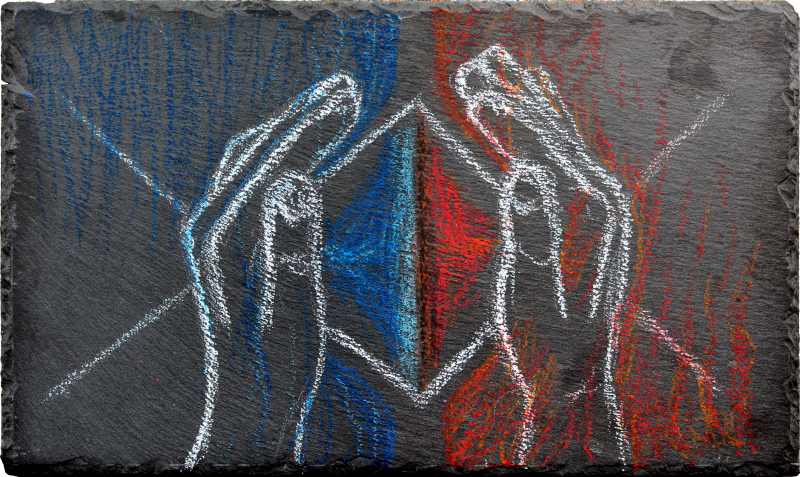8. Ingwas Rune
By doing Isa, we are now holding opposites aside, and through their separation, the creative force of Emptiness reveals itself, so we can feel it between our hands. But we need space for everything to happen.
When you hold palms close to each other, from the outside you feel the pressure of the Fire and Water trying to reunite, and from inside you feel springy resistance of Emptiness preventing them from touching each other.
Try to gently sway your palms making them a bit closer and backward, just a few millimeters. Do you feel your palms glued in some position, so something resists your attempts to move them in both directions in and out?
Let's change this static balance and make a cavity. Instead of moving your flat palms wider, slowly bend them into an angular shape, so you will see a slowly widening rhombus of emptiness between your hands. This yet-empty cavity stretched from the thin border of Emptiness between Fire and Water is the shell of the Ingwaz rune.
In the horizontal view, it looks like this:
External pressure is applied from the Fire to the right hand and from the Water to the left one and tries to flatten your palms back and restore emptiness as a thin stable layer of Isa.
But we will resist this pressure collasp things back and rotate the system of coordinates into a vertical position:
- Move your left hand from the left side to the top of the rhombic cavity, so instead of the left corner your bent angular palm will cover its upper tip.
- At the same time slide your right hand to the bottom of the rhombus and rotate the palm in a comfortable right-to-left direction, so your right hand now supports it from the bottom tip.
There are two historical versions of the Ingwaz rune. One is a double-crossing angle:
And another is simplified to central rhombus only:
In this book, we will use the first, complex version, because it aligns with the Kenaz rune and indicates the important roles of Water and Fire in this process.
From a structural perspective of Runic Alchemy, Ingwaz is a combination of crossed Kenaz and its mirror. Separation and reunion.
The name "Ingwaz" is a proto-germanic reconstruction of "Yngvi", of the Freyr's names, which is associated with kingship, fertility, peace, prosperity, fair weather, and good harvest.
Though this is modern perspective, it's interesting how the geometry of the Ingwaz rune resembles a double-helix of DNA. It's amazing how organically the symbolism of fertility and reproduction comes out of it.
Now let's see what these upper and lower "chevrons" stand for from Runic Alchemy perspective. They are not directly represented by our hand gestures, expanding above and below, but let's see what role they play.
Carefully let the Water from the top and Fire from the bottom come inside the empty cavity right through your palm energy centers:

It's ok to not "see" it, but if you did it more or less right - it happens on its own:
- Water and Fire, in equal proportions injected inside the Ingwaz shell, meet in the center of the Emptiness.
- The Water in contact with the Fire is heated and evaporates into the Air, the essence of transparency, so the potential quality of transparency is extracted from the Water and concentrated above the Emptiness in the form of the yet dark and smoky Air.
- The Fire in contact with the Water cools down and solidifies, so the quality of heaviness and density is being collected from the Fire and, like a slug running out of fire, condensed into dark hardness below the line of Emptiness - the raw Earth.
- It's dark because opaque Earth, like a black fertile volcanic soil, blocks the light of the Fire from beneath.
As a letter, the Ingwaz rune represents the sound "ŋ", which in Germanic languages (-ing / -ung) usually indicates some action as a process or its result.
The alchemical process defined by Ingwaz rune you don't directly control. You just hold this egg, let Fire and Water get inside in a controlled way, and observe what's happening inside and what's coming out of it. It's okay if something isn't working yet or isn't ideal, or you just don't see feel or grasp all the details. It's supposed by the non-chronological structure of this work to move ahead and return as many times as needed.
At the end of the first phase, when you have the egg of Ingwaz stretched between your palms and rotated into a vertical position, your left Water hand covers the north pole of future Mnidgard while your right Fire hand supports it from the south pole, you can feel how first three runes Kenaz, Isa, and Ingwaz naturally come from each other:
This is how you undertake the first phase of the alchemical process. Those familiar with Norse creation myth may see here the very beginning of the tale, describing how the sleeping proto-giant Ymir emerged from the interaction between Water of Niflheim and Fire of Muspelheim happened in the Emptiness Ginnungagap.
